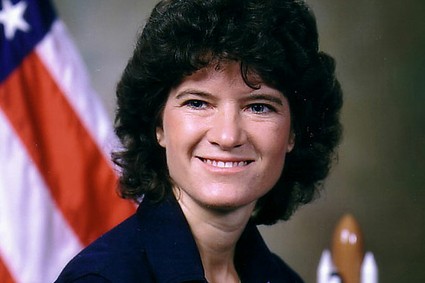A Tribute to Sally Ride: 1952-2012

When I was a kid, the “Race for Space” was a big deal.
I remember my sisters and I, jumping around the living room on two legs in “slo-mo”, trying to imitate the astronauts bounding about on the moon.
We wondered what it would be like to be out in space, looking back at the earth. But all American astronauts were men.
That is, until 1983, when Sally Ride became the first American woman in space- blasting off on the space shuttle Challenger.
“The thing that I’ll remember most about the flight is that it was fun,”said Sally.“In fact, I’m sure it was the most fun I’ll ever have in my life.”
She flew a second shuttle mission in 1984, and was scheduled for a third mission in 1986, but it was cancelled when the Challenger exploded shortly after takeoff, killing all seven crewmembers.
Ride served on the Presidential Commission investigating the tragedy, and retired from NASA in 1987.
She went back to her roots and joined the faculty of the University of California San Diego as a professor of physics and director of the California Space Institute.
But more importantly, she founded her own company, called Sally Ride Science. With Sally Ride Science, she hoped to pursue her “long-time passion for motivating young girls and boys to stick with their interests in science and to consider pursuing careers in science, technology, engineering, and math.” She wrote science books and directed NASA funded education initiatives.
Seventeen months ago, Sally Ride was diagnosed with pancreatic cancer. She died peacefully at home on July 23.
Pancreatic Adenocarcinoma
 Pancreatic adenocarcinoma is a cancerous overgrowth of exocrine pancreatic cells. The exocrine pancreas consists of cells which produce a pancreatic juice that includes enzymes which aid in the digestion of food in the small intestine, breaking up proteins, carbohydrates and fats.
Pancreatic adenocarcinoma is a cancerous overgrowth of exocrine pancreatic cells. The exocrine pancreas consists of cells which produce a pancreatic juice that includes enzymes which aid in the digestion of food in the small intestine, breaking up proteins, carbohydrates and fats.
Pancreatic cancer is the fourth leading cause of cancer death for both men and women.
- Pancreatic cancer is one of the most deadly of all types of cancer.
- This year 44,030 Americans will be diagnosed with pancreatic cancer and about 37,660 will die from it.
- Despite the high mortality rate, the federal government spends woefully little money on pancreatic cancer research (only about 2% of a 5 billion dollar budget)
Pancreatic cancer is treatable when caught early; Unfortunately, the vast majority of cases are not diagnosed until too late.
- Five-year survival rates approach 40% if the cancers are surgically removed while they are still small and have not spread to the lymph nodes.
Pancreatic cancer is difficult to diagnose
- There is no reliable screening test for the early detection of pancreatic cancer.
- Symptoms are often vague and easily confused with other diseases:
- Dark urine and clay-colored stools
- Fatigue and weakness
- Jaundice (a yellow color in the skin, mucus membranes, or eyes)
- Loss of appetite and weight loss
- Nausea and vomiting
- Pain or discomfort in the upper part of the belly or abdomen
- Back pain
- Blood clots
- Diarrhea
- Indigestion
Who Has the Greatest Risk?
Inherited genetic disorders cause 5-10% of cases of pancreatic cancer and certain genes can increase the lifetime risk up 80%.
- People with two or more relatives who have had pancreatic cancer
- Cigarette smokers
- People of Ashkenazi Jewish descent
- Have the BRCA2, p16, STK11 gene mutation or chronic pancreatitis (inflammation of the pancreas)
- Are over the age of 50
Because pancreatic cancer is often advanced when it is first found, very few pancreatic tumors can be removed by surgery. The standard surgical procedure is called a pancreaticoduodenectomy (Whipple procedure).
When the tumor has not spread out of the pancreas but cannot be removed, radiation therapy and chemotherapy together may be recommended.
When the tumor has spread (metastasized) to other organs such as the liver, chemotherapy alone is usually used. The standard chemotherapy drug is gemcitabine, but other drugs may be used. Gemcitabine can help about 25% of patients.
Managing pain and other symptoms is an important part of treating advanced pancreatic cancer. Palliative care tams and hospice can help with pain and symptom management, and provide psychological support for patients and their families during the illness.



























0 comments